Workplace Health and Safety Legislation: Planning and Assessment
VerifiedAdded on 2021/12/29
|18
|4224
|33
Homework Assignment
AI Summary
This document presents a detailed solution to a Workplace Health and Safety (WHS) assignment, addressing various aspects of WHS legislation. The assignment covers key areas such as consultation with workers, providing staff with WHS information, developing emergency evacuation plans and other relevant WHS procedures. It includes methods for monitoring staff compliance, identifying and managing WHS issues, and documenting compliance with WHS laws. The solution also outlines steps to take when staff members don't comply with WHS practices and addresses the importance of communication in resolving WHS issues. Furthermore, the assignment provides guidance on risk management, WHS training methods, and the storage of safety data sheets (SDS). It also explores the employer's duty of care, the role of the WHS committee, and penalties for non-compliance. Part A of the assignment focuses on planning WHS systems, consultation, and risk assessment for specific situations, including emergency evacuations, handling sharp equipment and chemicals, and hazardous substances and provides implementation plans and required records.
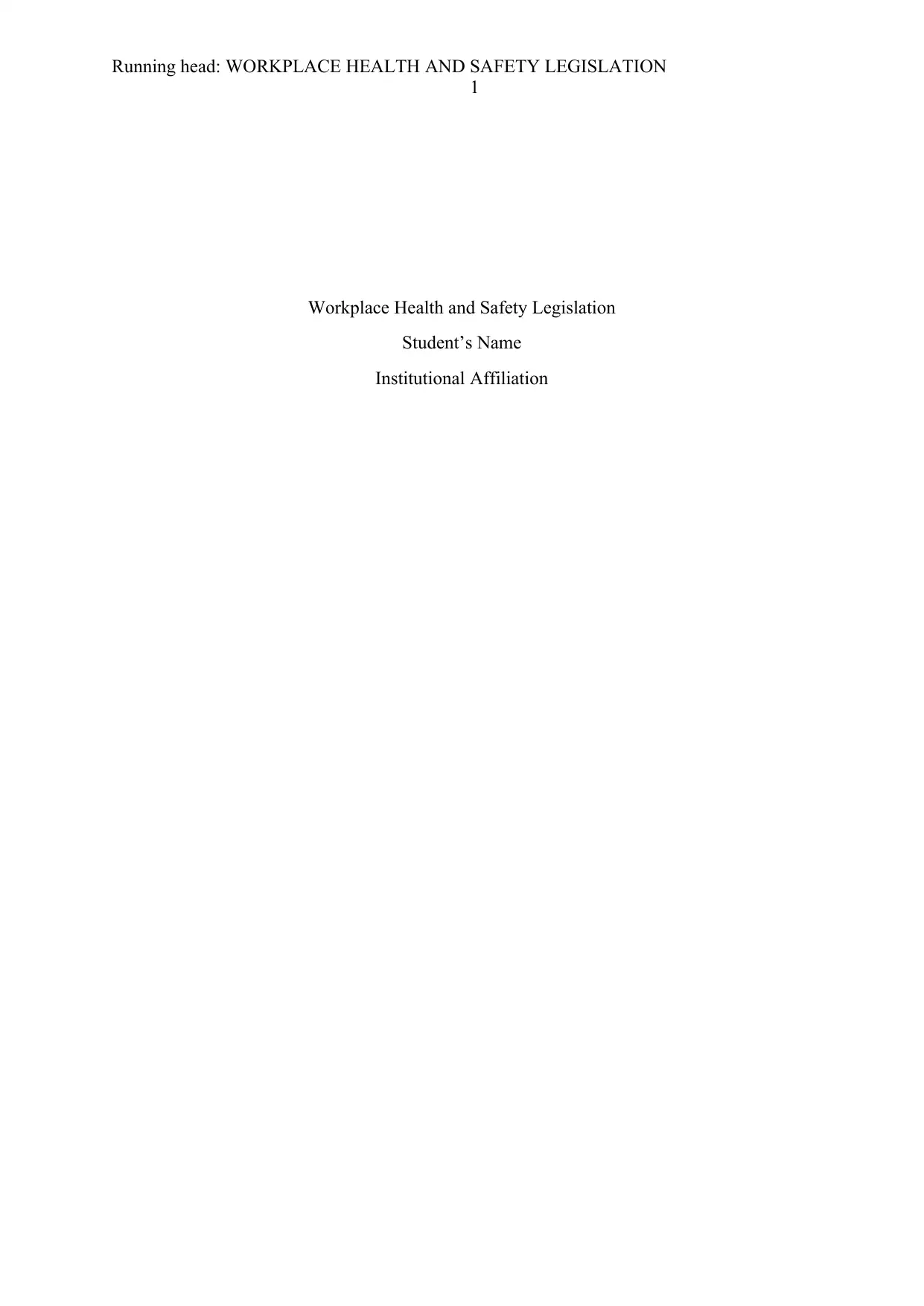
Running head: WORKPLACE HEALTH AND SAFETY LEGISLATION
1
Workplace Health and Safety Legislation
Student’s Name
Institutional Affiliation
1
Workplace Health and Safety Legislation
Student’s Name
Institutional Affiliation
Paraphrase This Document
Need a fresh take? Get an instant paraphrase of this document with our AI Paraphraser
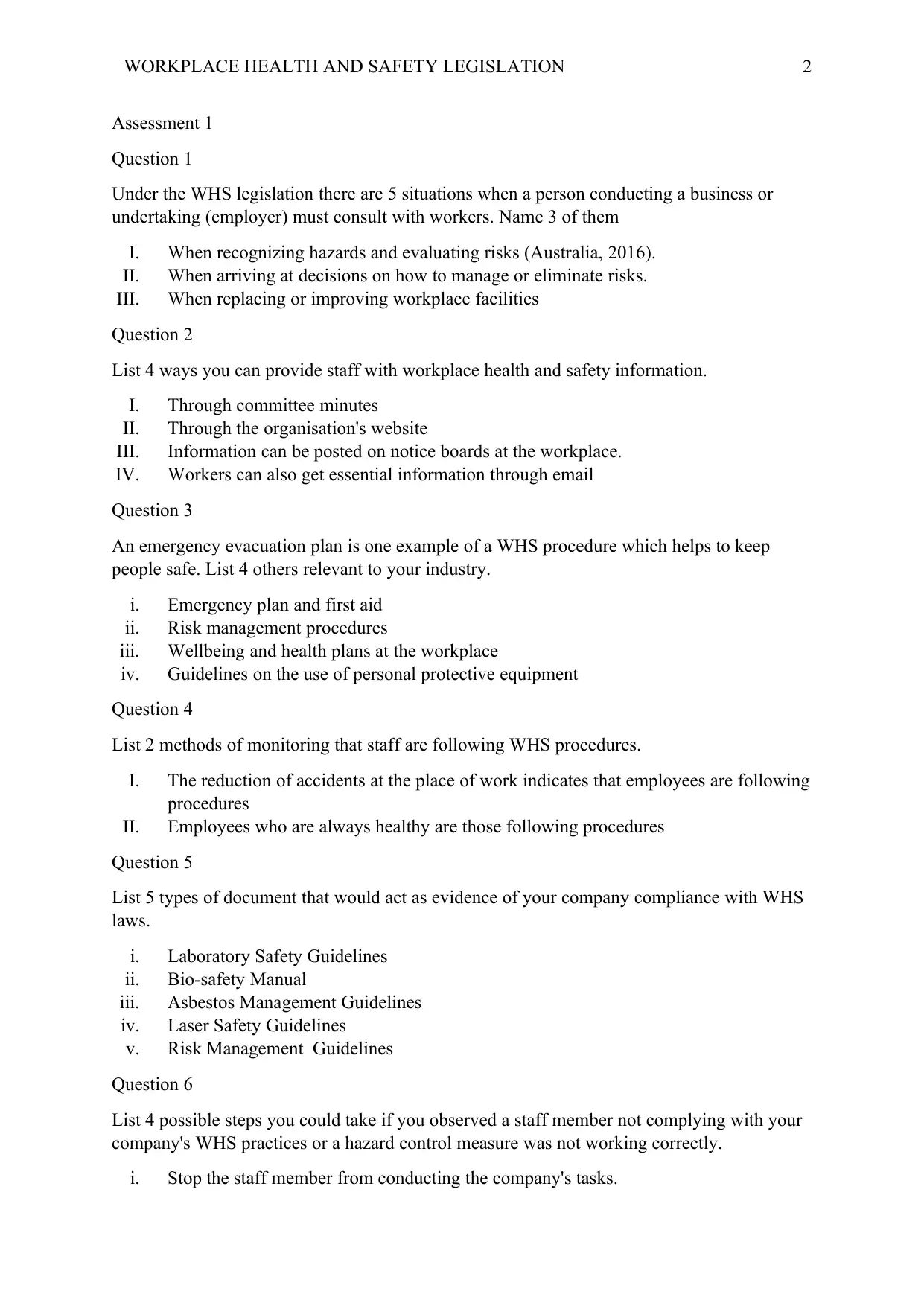
WORKPLACE HEALTH AND SAFETY LEGISLATION 2
Assessment 1
Question 1
Under the WHS legislation there are 5 situations when a person conducting a business or
undertaking (employer) must consult with workers. Name 3 of them
I. When recognizing hazards and evaluating risks (Australia, 2016).
II. When arriving at decisions on how to manage or eliminate risks.
III. When replacing or improving workplace facilities
Question 2
List 4 ways you can provide staff with workplace health and safety information.
I. Through committee minutes
II. Through the organisation's website
III. Information can be posted on notice boards at the workplace.
IV. Workers can also get essential information through email
Question 3
An emergency evacuation plan is one example of a WHS procedure which helps to keep
people safe. List 4 others relevant to your industry.
i. Emergency plan and first aid
ii. Risk management procedures
iii. Wellbeing and health plans at the workplace
iv. Guidelines on the use of personal protective equipment
Question 4
List 2 methods of monitoring that staff are following WHS procedures.
I. The reduction of accidents at the place of work indicates that employees are following
procedures
II. Employees who are always healthy are those following procedures
Question 5
List 5 types of document that would act as evidence of your company compliance with WHS
laws.
i. Laboratory Safety Guidelines
ii. Bio-safety Manual
iii. Asbestos Management Guidelines
iv. Laser Safety Guidelines
v. Risk Management Guidelines
Question 6
List 4 possible steps you could take if you observed a staff member not complying with your
company's WHS practices or a hazard control measure was not working correctly.
i. Stop the staff member from conducting the company's tasks.
Assessment 1
Question 1
Under the WHS legislation there are 5 situations when a person conducting a business or
undertaking (employer) must consult with workers. Name 3 of them
I. When recognizing hazards and evaluating risks (Australia, 2016).
II. When arriving at decisions on how to manage or eliminate risks.
III. When replacing or improving workplace facilities
Question 2
List 4 ways you can provide staff with workplace health and safety information.
I. Through committee minutes
II. Through the organisation's website
III. Information can be posted on notice boards at the workplace.
IV. Workers can also get essential information through email
Question 3
An emergency evacuation plan is one example of a WHS procedure which helps to keep
people safe. List 4 others relevant to your industry.
i. Emergency plan and first aid
ii. Risk management procedures
iii. Wellbeing and health plans at the workplace
iv. Guidelines on the use of personal protective equipment
Question 4
List 2 methods of monitoring that staff are following WHS procedures.
I. The reduction of accidents at the place of work indicates that employees are following
procedures
II. Employees who are always healthy are those following procedures
Question 5
List 5 types of document that would act as evidence of your company compliance with WHS
laws.
i. Laboratory Safety Guidelines
ii. Bio-safety Manual
iii. Asbestos Management Guidelines
iv. Laser Safety Guidelines
v. Risk Management Guidelines
Question 6
List 4 possible steps you could take if you observed a staff member not complying with your
company's WHS practices or a hazard control measure was not working correctly.
i. Stop the staff member from conducting the company's tasks.
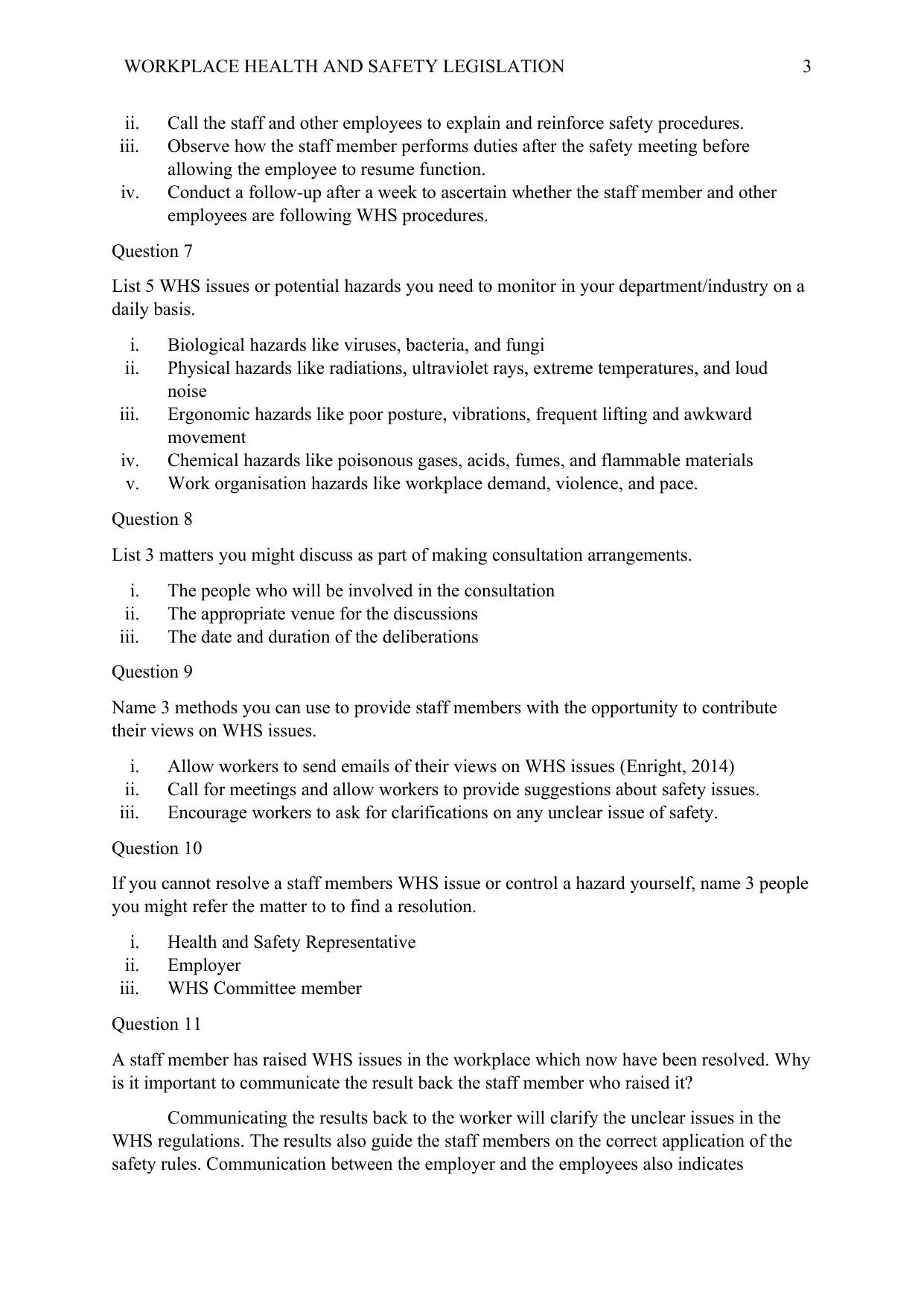
WORKPLACE HEALTH AND SAFETY LEGISLATION 3
ii. Call the staff and other employees to explain and reinforce safety procedures.
iii. Observe how the staff member performs duties after the safety meeting before
allowing the employee to resume function.
iv. Conduct a follow-up after a week to ascertain whether the staff member and other
employees are following WHS procedures.
Question 7
List 5 WHS issues or potential hazards you need to monitor in your department/industry on a
daily basis.
i. Biological hazards like viruses, bacteria, and fungi
ii. Physical hazards like radiations, ultraviolet rays, extreme temperatures, and loud
noise
iii. Ergonomic hazards like poor posture, vibrations, frequent lifting and awkward
movement
iv. Chemical hazards like poisonous gases, acids, fumes, and flammable materials
v. Work organisation hazards like workplace demand, violence, and pace.
Question 8
List 3 matters you might discuss as part of making consultation arrangements.
i. The people who will be involved in the consultation
ii. The appropriate venue for the discussions
iii. The date and duration of the deliberations
Question 9
Name 3 methods you can use to provide staff members with the opportunity to contribute
their views on WHS issues.
i. Allow workers to send emails of their views on WHS issues (Enright, 2014)
ii. Call for meetings and allow workers to provide suggestions about safety issues.
iii. Encourage workers to ask for clarifications on any unclear issue of safety.
Question 10
If you cannot resolve a staff members WHS issue or control a hazard yourself, name 3 people
you might refer the matter to to find a resolution.
i. Health and Safety Representative
ii. Employer
iii. WHS Committee member
Question 11
A staff member has raised WHS issues in the workplace which now have been resolved. Why
is it important to communicate the result back the staff member who raised it?
Communicating the results back to the worker will clarify the unclear issues in the
WHS regulations. The results also guide the staff members on the correct application of the
safety rules. Communication between the employer and the employees also indicates
ii. Call the staff and other employees to explain and reinforce safety procedures.
iii. Observe how the staff member performs duties after the safety meeting before
allowing the employee to resume function.
iv. Conduct a follow-up after a week to ascertain whether the staff member and other
employees are following WHS procedures.
Question 7
List 5 WHS issues or potential hazards you need to monitor in your department/industry on a
daily basis.
i. Biological hazards like viruses, bacteria, and fungi
ii. Physical hazards like radiations, ultraviolet rays, extreme temperatures, and loud
noise
iii. Ergonomic hazards like poor posture, vibrations, frequent lifting and awkward
movement
iv. Chemical hazards like poisonous gases, acids, fumes, and flammable materials
v. Work organisation hazards like workplace demand, violence, and pace.
Question 8
List 3 matters you might discuss as part of making consultation arrangements.
i. The people who will be involved in the consultation
ii. The appropriate venue for the discussions
iii. The date and duration of the deliberations
Question 9
Name 3 methods you can use to provide staff members with the opportunity to contribute
their views on WHS issues.
i. Allow workers to send emails of their views on WHS issues (Enright, 2014)
ii. Call for meetings and allow workers to provide suggestions about safety issues.
iii. Encourage workers to ask for clarifications on any unclear issue of safety.
Question 10
If you cannot resolve a staff members WHS issue or control a hazard yourself, name 3 people
you might refer the matter to to find a resolution.
i. Health and Safety Representative
ii. Employer
iii. WHS Committee member
Question 11
A staff member has raised WHS issues in the workplace which now have been resolved. Why
is it important to communicate the result back the staff member who raised it?
Communicating the results back to the worker will clarify the unclear issues in the
WHS regulations. The results also guide the staff members on the correct application of the
safety rules. Communication between the employer and the employees also indicates
⊘ This is a preview!⊘
Do you want full access?
Subscribe today to unlock all pages.

Trusted by 1+ million students worldwide
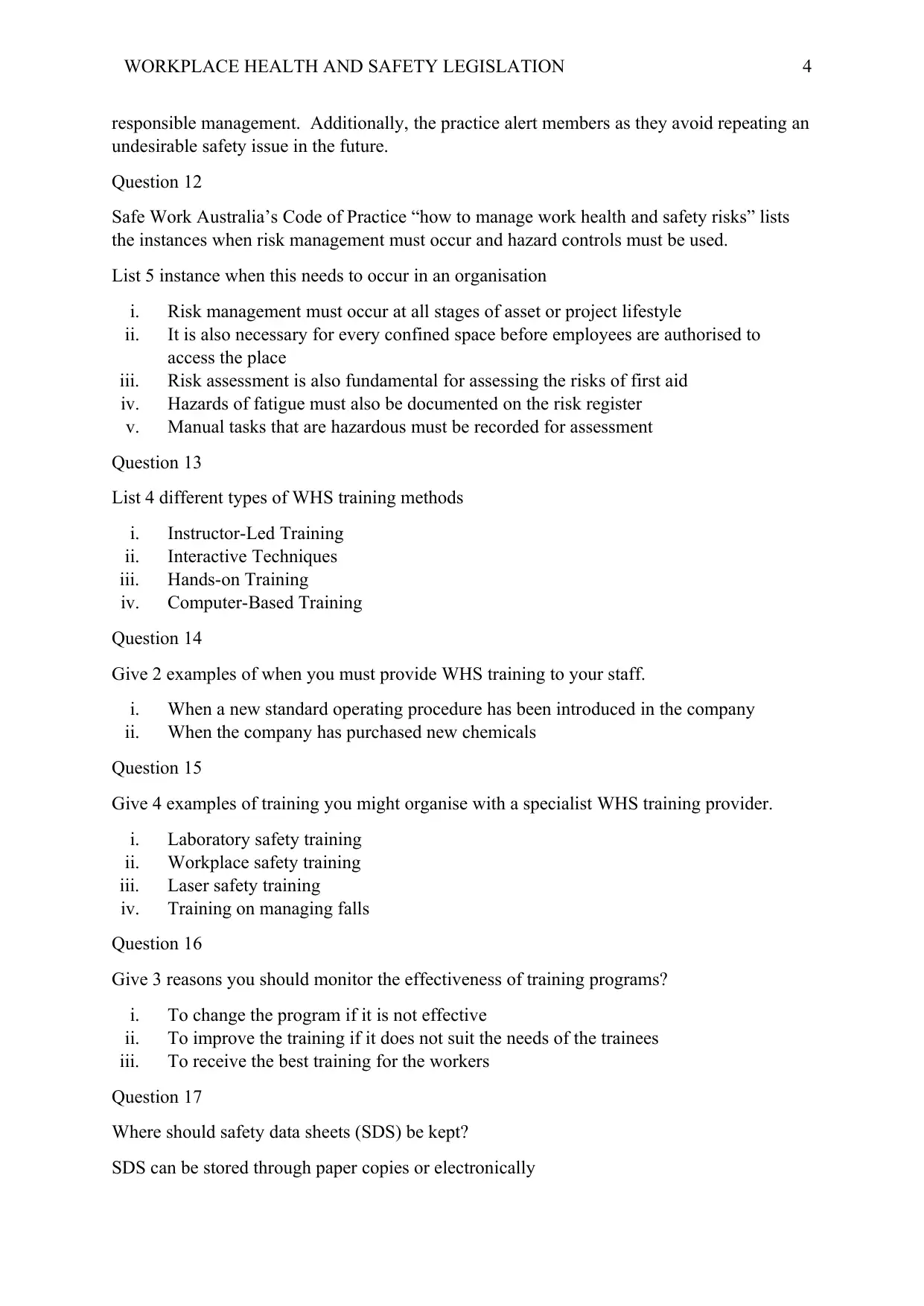
WORKPLACE HEALTH AND SAFETY LEGISLATION 4
responsible management. Additionally, the practice alert members as they avoid repeating an
undesirable safety issue in the future.
Question 12
Safe Work Australia’s Code of Practice “how to manage work health and safety risks” lists
the instances when risk management must occur and hazard controls must be used.
List 5 instance when this needs to occur in an organisation
i. Risk management must occur at all stages of asset or project lifestyle
ii. It is also necessary for every confined space before employees are authorised to
access the place
iii. Risk assessment is also fundamental for assessing the risks of first aid
iv. Hazards of fatigue must also be documented on the risk register
v. Manual tasks that are hazardous must be recorded for assessment
Question 13
List 4 different types of WHS training methods
i. Instructor-Led Training
ii. Interactive Techniques
iii. Hands-on Training
iv. Computer-Based Training
Question 14
Give 2 examples of when you must provide WHS training to your staff.
i. When a new standard operating procedure has been introduced in the company
ii. When the company has purchased new chemicals
Question 15
Give 4 examples of training you might organise with a specialist WHS training provider.
i. Laboratory safety training
ii. Workplace safety training
iii. Laser safety training
iv. Training on managing falls
Question 16
Give 3 reasons you should monitor the effectiveness of training programs?
i. To change the program if it is not effective
ii. To improve the training if it does not suit the needs of the trainees
iii. To receive the best training for the workers
Question 17
Where should safety data sheets (SDS) be kept?
SDS can be stored through paper copies or electronically
responsible management. Additionally, the practice alert members as they avoid repeating an
undesirable safety issue in the future.
Question 12
Safe Work Australia’s Code of Practice “how to manage work health and safety risks” lists
the instances when risk management must occur and hazard controls must be used.
List 5 instance when this needs to occur in an organisation
i. Risk management must occur at all stages of asset or project lifestyle
ii. It is also necessary for every confined space before employees are authorised to
access the place
iii. Risk assessment is also fundamental for assessing the risks of first aid
iv. Hazards of fatigue must also be documented on the risk register
v. Manual tasks that are hazardous must be recorded for assessment
Question 13
List 4 different types of WHS training methods
i. Instructor-Led Training
ii. Interactive Techniques
iii. Hands-on Training
iv. Computer-Based Training
Question 14
Give 2 examples of when you must provide WHS training to your staff.
i. When a new standard operating procedure has been introduced in the company
ii. When the company has purchased new chemicals
Question 15
Give 4 examples of training you might organise with a specialist WHS training provider.
i. Laboratory safety training
ii. Workplace safety training
iii. Laser safety training
iv. Training on managing falls
Question 16
Give 3 reasons you should monitor the effectiveness of training programs?
i. To change the program if it is not effective
ii. To improve the training if it does not suit the needs of the trainees
iii. To receive the best training for the workers
Question 17
Where should safety data sheets (SDS) be kept?
SDS can be stored through paper copies or electronically
Paraphrase This Document
Need a fresh take? Get an instant paraphrase of this document with our AI Paraphraser
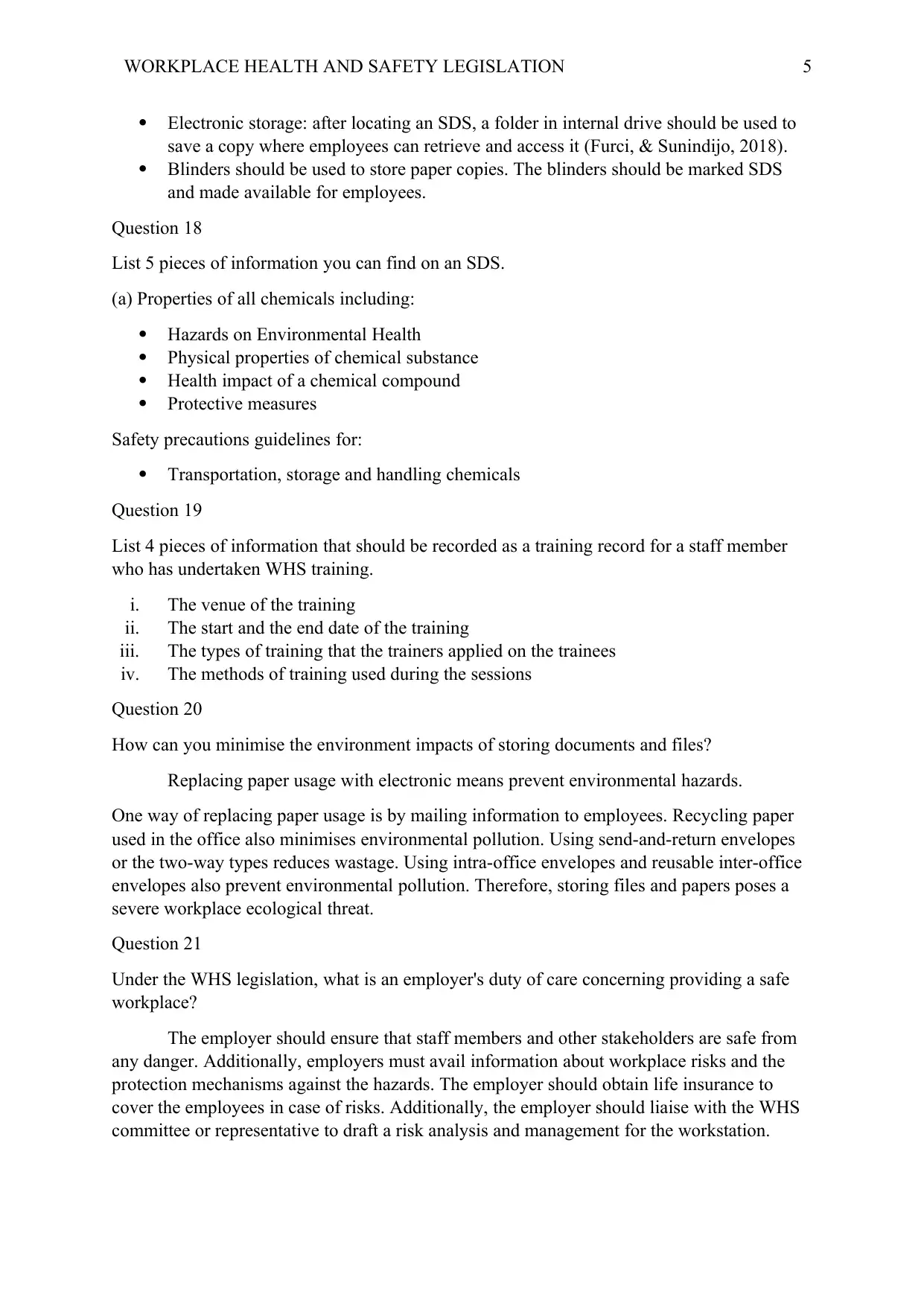
WORKPLACE HEALTH AND SAFETY LEGISLATION 5
Electronic storage: after locating an SDS, a folder in internal drive should be used to
save a copy where employees can retrieve and access it (Furci, & Sunindijo, 2018).
Blinders should be used to store paper copies. The blinders should be marked SDS
and made available for employees.
Question 18
List 5 pieces of information you can find on an SDS.
(a) Properties of all chemicals including:
Hazards on Environmental Health
Physical properties of chemical substance
Health impact of a chemical compound
Protective measures
Safety precautions guidelines for:
Transportation, storage and handling chemicals
Question 19
List 4 pieces of information that should be recorded as a training record for a staff member
who has undertaken WHS training.
i. The venue of the training
ii. The start and the end date of the training
iii. The types of training that the trainers applied on the trainees
iv. The methods of training used during the sessions
Question 20
How can you minimise the environment impacts of storing documents and files?
Replacing paper usage with electronic means prevent environmental hazards.
One way of replacing paper usage is by mailing information to employees. Recycling paper
used in the office also minimises environmental pollution. Using send-and-return envelopes
or the two-way types reduces wastage. Using intra-office envelopes and reusable inter-office
envelopes also prevent environmental pollution. Therefore, storing files and papers poses a
severe workplace ecological threat.
Question 21
Under the WHS legislation, what is an employer's duty of care concerning providing a safe
workplace?
The employer should ensure that staff members and other stakeholders are safe from
any danger. Additionally, employers must avail information about workplace risks and the
protection mechanisms against the hazards. The employer should obtain life insurance to
cover the employees in case of risks. Additionally, the employer should liaise with the WHS
committee or representative to draft a risk analysis and management for the workstation.
Electronic storage: after locating an SDS, a folder in internal drive should be used to
save a copy where employees can retrieve and access it (Furci, & Sunindijo, 2018).
Blinders should be used to store paper copies. The blinders should be marked SDS
and made available for employees.
Question 18
List 5 pieces of information you can find on an SDS.
(a) Properties of all chemicals including:
Hazards on Environmental Health
Physical properties of chemical substance
Health impact of a chemical compound
Protective measures
Safety precautions guidelines for:
Transportation, storage and handling chemicals
Question 19
List 4 pieces of information that should be recorded as a training record for a staff member
who has undertaken WHS training.
i. The venue of the training
ii. The start and the end date of the training
iii. The types of training that the trainers applied on the trainees
iv. The methods of training used during the sessions
Question 20
How can you minimise the environment impacts of storing documents and files?
Replacing paper usage with electronic means prevent environmental hazards.
One way of replacing paper usage is by mailing information to employees. Recycling paper
used in the office also minimises environmental pollution. Using send-and-return envelopes
or the two-way types reduces wastage. Using intra-office envelopes and reusable inter-office
envelopes also prevent environmental pollution. Therefore, storing files and papers poses a
severe workplace ecological threat.
Question 21
Under the WHS legislation, what is an employer's duty of care concerning providing a safe
workplace?
The employer should ensure that staff members and other stakeholders are safe from
any danger. Additionally, employers must avail information about workplace risks and the
protection mechanisms against the hazards. The employer should obtain life insurance to
cover the employees in case of risks. Additionally, the employer should liaise with the WHS
committee or representative to draft a risk analysis and management for the workstation.
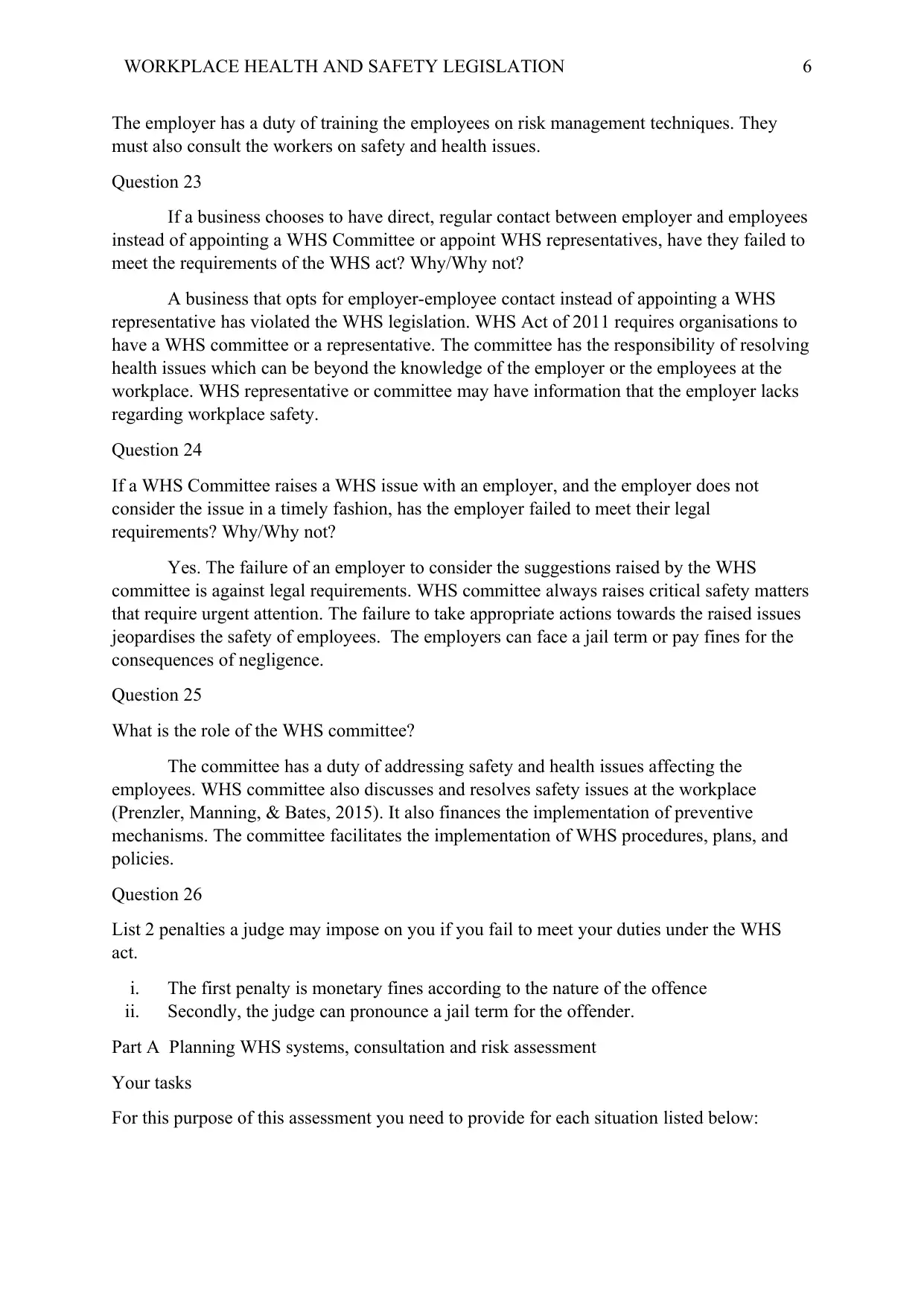
WORKPLACE HEALTH AND SAFETY LEGISLATION 6
The employer has a duty of training the employees on risk management techniques. They
must also consult the workers on safety and health issues.
Question 23
If a business chooses to have direct, regular contact between employer and employees
instead of appointing a WHS Committee or appoint WHS representatives, have they failed to
meet the requirements of the WHS act? Why/Why not?
A business that opts for employer-employee contact instead of appointing a WHS
representative has violated the WHS legislation. WHS Act of 2011 requires organisations to
have a WHS committee or a representative. The committee has the responsibility of resolving
health issues which can be beyond the knowledge of the employer or the employees at the
workplace. WHS representative or committee may have information that the employer lacks
regarding workplace safety.
Question 24
If a WHS Committee raises a WHS issue with an employer, and the employer does not
consider the issue in a timely fashion, has the employer failed to meet their legal
requirements? Why/Why not?
Yes. The failure of an employer to consider the suggestions raised by the WHS
committee is against legal requirements. WHS committee always raises critical safety matters
that require urgent attention. The failure to take appropriate actions towards the raised issues
jeopardises the safety of employees. The employers can face a jail term or pay fines for the
consequences of negligence.
Question 25
What is the role of the WHS committee?
The committee has a duty of addressing safety and health issues affecting the
employees. WHS committee also discusses and resolves safety issues at the workplace
(Prenzler, Manning, & Bates, 2015). It also finances the implementation of preventive
mechanisms. The committee facilitates the implementation of WHS procedures, plans, and
policies.
Question 26
List 2 penalties a judge may impose on you if you fail to meet your duties under the WHS
act.
i. The first penalty is monetary fines according to the nature of the offence
ii. Secondly, the judge can pronounce a jail term for the offender.
Part A Planning WHS systems, consultation and risk assessment
Your tasks
For this purpose of this assessment you need to provide for each situation listed below:
The employer has a duty of training the employees on risk management techniques. They
must also consult the workers on safety and health issues.
Question 23
If a business chooses to have direct, regular contact between employer and employees
instead of appointing a WHS Committee or appoint WHS representatives, have they failed to
meet the requirements of the WHS act? Why/Why not?
A business that opts for employer-employee contact instead of appointing a WHS
representative has violated the WHS legislation. WHS Act of 2011 requires organisations to
have a WHS committee or a representative. The committee has the responsibility of resolving
health issues which can be beyond the knowledge of the employer or the employees at the
workplace. WHS representative or committee may have information that the employer lacks
regarding workplace safety.
Question 24
If a WHS Committee raises a WHS issue with an employer, and the employer does not
consider the issue in a timely fashion, has the employer failed to meet their legal
requirements? Why/Why not?
Yes. The failure of an employer to consider the suggestions raised by the WHS
committee is against legal requirements. WHS committee always raises critical safety matters
that require urgent attention. The failure to take appropriate actions towards the raised issues
jeopardises the safety of employees. The employers can face a jail term or pay fines for the
consequences of negligence.
Question 25
What is the role of the WHS committee?
The committee has a duty of addressing safety and health issues affecting the
employees. WHS committee also discusses and resolves safety issues at the workplace
(Prenzler, Manning, & Bates, 2015). It also finances the implementation of preventive
mechanisms. The committee facilitates the implementation of WHS procedures, plans, and
policies.
Question 26
List 2 penalties a judge may impose on you if you fail to meet your duties under the WHS
act.
i. The first penalty is monetary fines according to the nature of the offence
ii. Secondly, the judge can pronounce a jail term for the offender.
Part A Planning WHS systems, consultation and risk assessment
Your tasks
For this purpose of this assessment you need to provide for each situation listed below:
⊘ This is a preview!⊘
Do you want full access?
Subscribe today to unlock all pages.

Trusted by 1+ million students worldwide
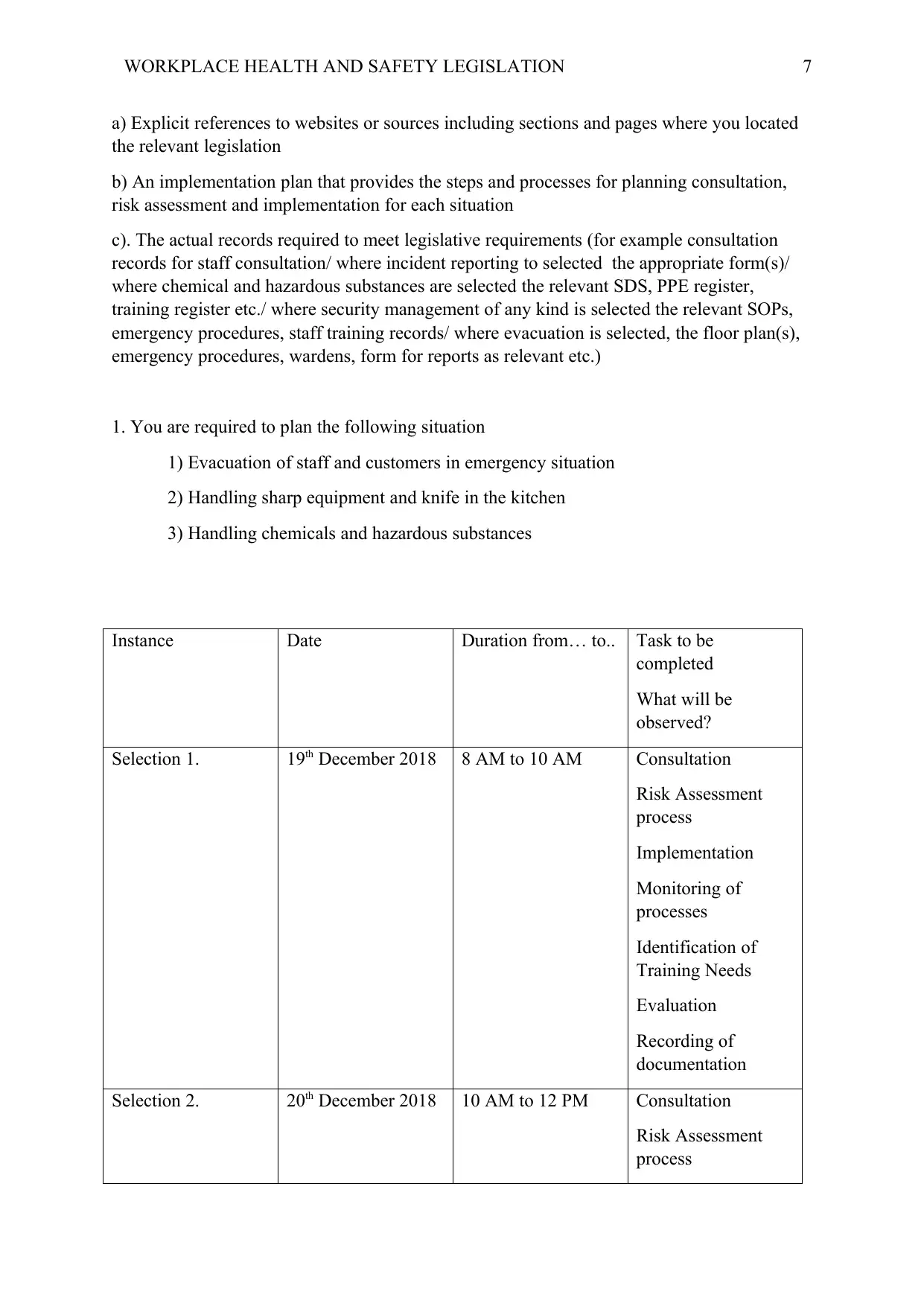
WORKPLACE HEALTH AND SAFETY LEGISLATION 7
a) Explicit references to websites or sources including sections and pages where you located
the relevant legislation
b) An implementation plan that provides the steps and processes for planning consultation,
risk assessment and implementation for each situation
c). The actual records required to meet legislative requirements (for example consultation
records for staff consultation/ where incident reporting to selected the appropriate form(s)/
where chemical and hazardous substances are selected the relevant SDS, PPE register,
training register etc./ where security management of any kind is selected the relevant SOPs,
emergency procedures, staff training records/ where evacuation is selected, the floor plan(s),
emergency procedures, wardens, form for reports as relevant etc.)
1. You are required to plan the following situation
1) Evacuation of staff and customers in emergency situation
2) Handling sharp equipment and knife in the kitchen
3) Handling chemicals and hazardous substances
Instance Date Duration from… to.. Task to be
completed
What will be
observed?
Selection 1. 19th December 2018 8 AM to 10 AM Consultation
Risk Assessment
process
Implementation
Monitoring of
processes
Identification of
Training Needs
Evaluation
Recording of
documentation
Selection 2. 20th December 2018 10 AM to 12 PM Consultation
Risk Assessment
process
a) Explicit references to websites or sources including sections and pages where you located
the relevant legislation
b) An implementation plan that provides the steps and processes for planning consultation,
risk assessment and implementation for each situation
c). The actual records required to meet legislative requirements (for example consultation
records for staff consultation/ where incident reporting to selected the appropriate form(s)/
where chemical and hazardous substances are selected the relevant SDS, PPE register,
training register etc./ where security management of any kind is selected the relevant SOPs,
emergency procedures, staff training records/ where evacuation is selected, the floor plan(s),
emergency procedures, wardens, form for reports as relevant etc.)
1. You are required to plan the following situation
1) Evacuation of staff and customers in emergency situation
2) Handling sharp equipment and knife in the kitchen
3) Handling chemicals and hazardous substances
Instance Date Duration from… to.. Task to be
completed
What will be
observed?
Selection 1. 19th December 2018 8 AM to 10 AM Consultation
Risk Assessment
process
Implementation
Monitoring of
processes
Identification of
Training Needs
Evaluation
Recording of
documentation
Selection 2. 20th December 2018 10 AM to 12 PM Consultation
Risk Assessment
process
Paraphrase This Document
Need a fresh take? Get an instant paraphrase of this document with our AI Paraphraser
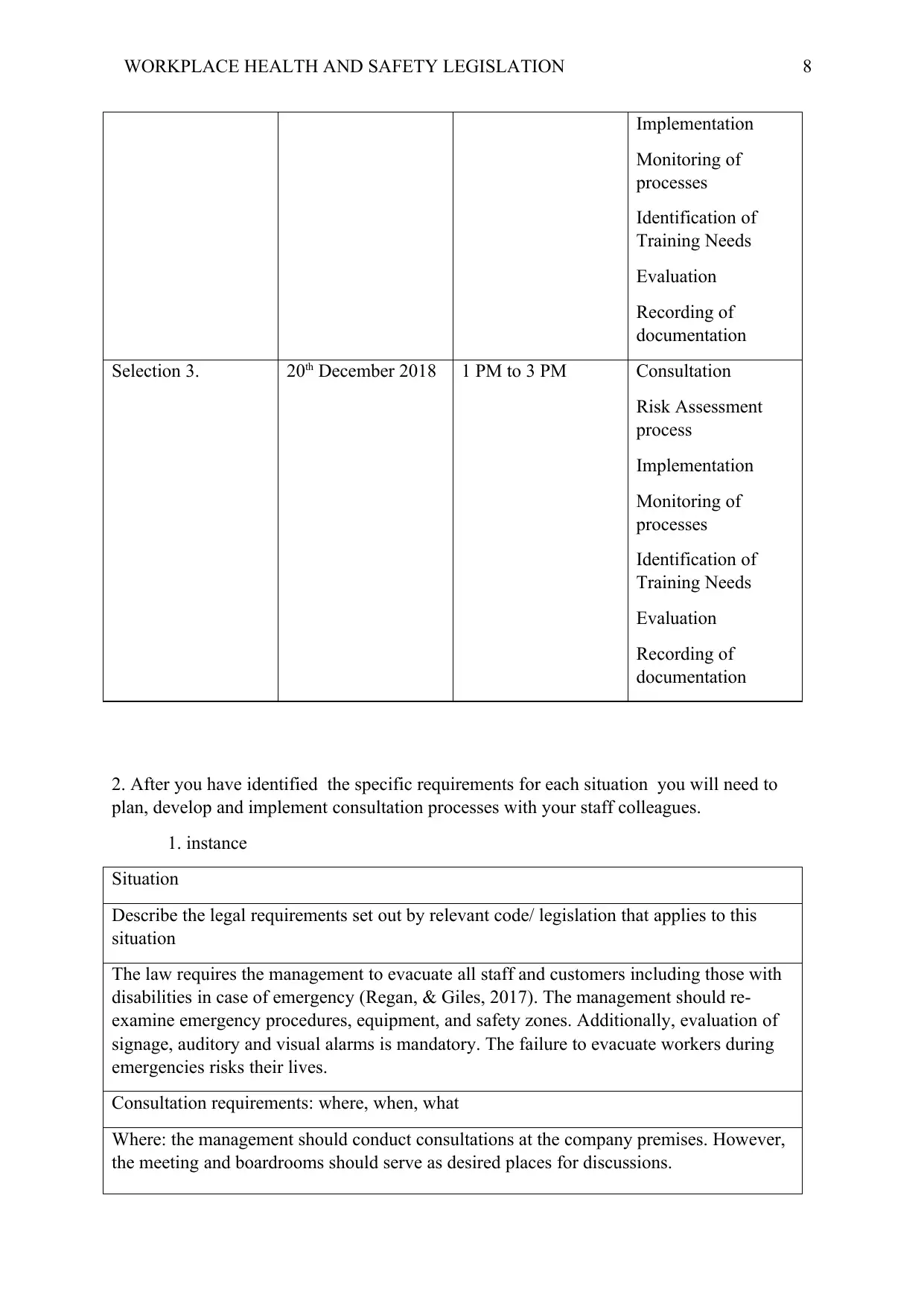
WORKPLACE HEALTH AND SAFETY LEGISLATION 8
Implementation
Monitoring of
processes
Identification of
Training Needs
Evaluation
Recording of
documentation
Selection 3. 20th December 2018 1 PM to 3 PM Consultation
Risk Assessment
process
Implementation
Monitoring of
processes
Identification of
Training Needs
Evaluation
Recording of
documentation
2. After you have identified the specific requirements for each situation you will need to
plan, develop and implement consultation processes with your staff colleagues.
1. instance
Situation
Describe the legal requirements set out by relevant code/ legislation that applies to this
situation
The law requires the management to evacuate all staff and customers including those with
disabilities in case of emergency (Regan, & Giles, 2017). The management should re-
examine emergency procedures, equipment, and safety zones. Additionally, evaluation of
signage, auditory and visual alarms is mandatory. The failure to evacuate workers during
emergencies risks their lives.
Consultation requirements: where, when, what
Where: the management should conduct consultations at the company premises. However,
the meeting and boardrooms should serve as desired places for discussions.
Implementation
Monitoring of
processes
Identification of
Training Needs
Evaluation
Recording of
documentation
Selection 3. 20th December 2018 1 PM to 3 PM Consultation
Risk Assessment
process
Implementation
Monitoring of
processes
Identification of
Training Needs
Evaluation
Recording of
documentation
2. After you have identified the specific requirements for each situation you will need to
plan, develop and implement consultation processes with your staff colleagues.
1. instance
Situation
Describe the legal requirements set out by relevant code/ legislation that applies to this
situation
The law requires the management to evacuate all staff and customers including those with
disabilities in case of emergency (Regan, & Giles, 2017). The management should re-
examine emergency procedures, equipment, and safety zones. Additionally, evaluation of
signage, auditory and visual alarms is mandatory. The failure to evacuate workers during
emergencies risks their lives.
Consultation requirements: where, when, what
Where: the management should conduct consultations at the company premises. However,
the meeting and boardrooms should serve as desired places for discussions.
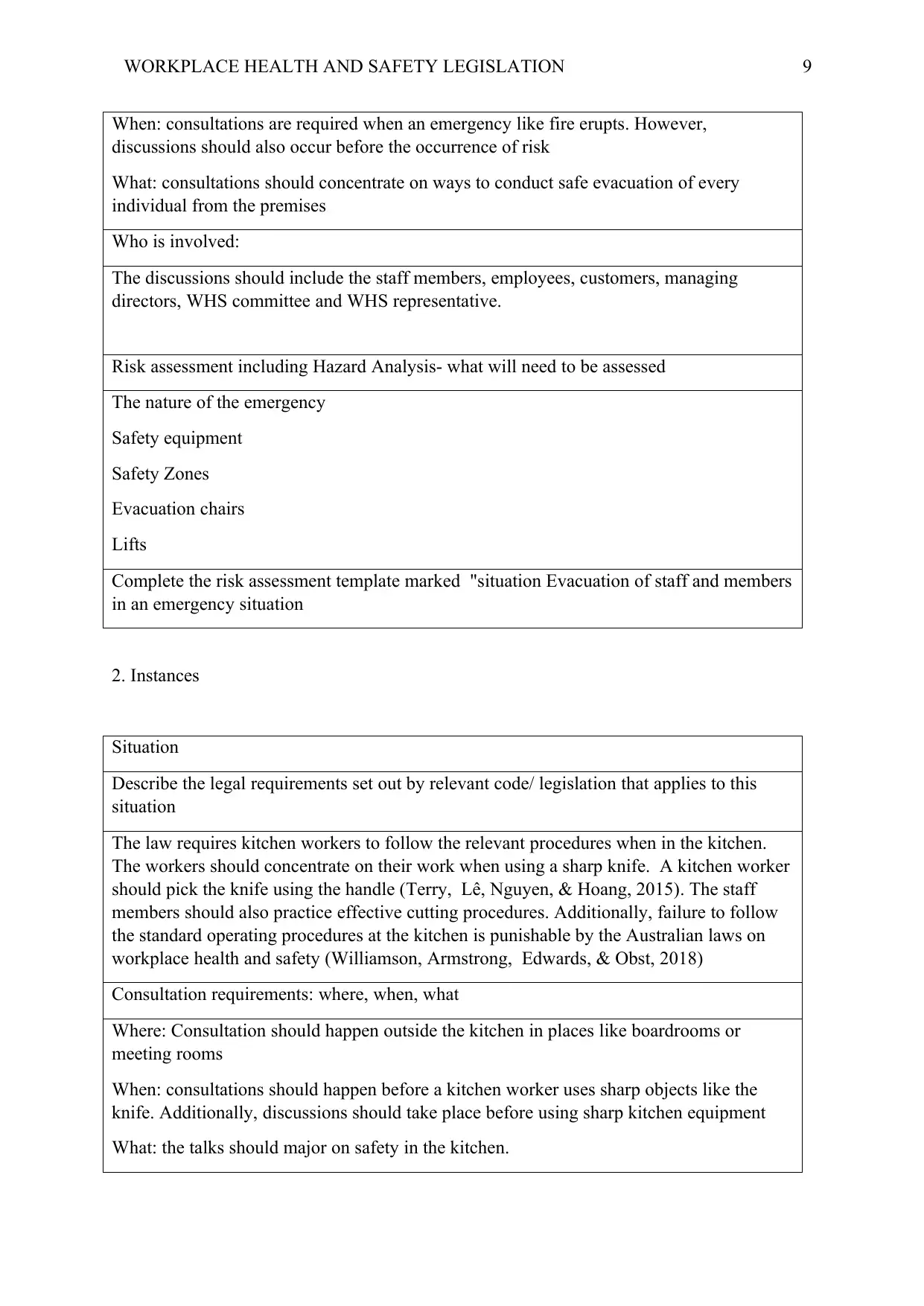
WORKPLACE HEALTH AND SAFETY LEGISLATION 9
When: consultations are required when an emergency like fire erupts. However,
discussions should also occur before the occurrence of risk
What: consultations should concentrate on ways to conduct safe evacuation of every
individual from the premises
Who is involved:
The discussions should include the staff members, employees, customers, managing
directors, WHS committee and WHS representative.
Risk assessment including Hazard Analysis- what will need to be assessed
The nature of the emergency
Safety equipment
Safety Zones
Evacuation chairs
Lifts
Complete the risk assessment template marked "situation Evacuation of staff and members
in an emergency situation
2. Instances
Situation
Describe the legal requirements set out by relevant code/ legislation that applies to this
situation
The law requires kitchen workers to follow the relevant procedures when in the kitchen.
The workers should concentrate on their work when using a sharp knife. A kitchen worker
should pick the knife using the handle (Terry, Lê, Nguyen, & Hoang, 2015). The staff
members should also practice effective cutting procedures. Additionally, failure to follow
the standard operating procedures at the kitchen is punishable by the Australian laws on
workplace health and safety (Williamson, Armstrong, Edwards, & Obst, 2018)
Consultation requirements: where, when, what
Where: Consultation should happen outside the kitchen in places like boardrooms or
meeting rooms
When: consultations should happen before a kitchen worker uses sharp objects like the
knife. Additionally, discussions should take place before using sharp kitchen equipment
What: the talks should major on safety in the kitchen.
When: consultations are required when an emergency like fire erupts. However,
discussions should also occur before the occurrence of risk
What: consultations should concentrate on ways to conduct safe evacuation of every
individual from the premises
Who is involved:
The discussions should include the staff members, employees, customers, managing
directors, WHS committee and WHS representative.
Risk assessment including Hazard Analysis- what will need to be assessed
The nature of the emergency
Safety equipment
Safety Zones
Evacuation chairs
Lifts
Complete the risk assessment template marked "situation Evacuation of staff and members
in an emergency situation
2. Instances
Situation
Describe the legal requirements set out by relevant code/ legislation that applies to this
situation
The law requires kitchen workers to follow the relevant procedures when in the kitchen.
The workers should concentrate on their work when using a sharp knife. A kitchen worker
should pick the knife using the handle (Terry, Lê, Nguyen, & Hoang, 2015). The staff
members should also practice effective cutting procedures. Additionally, failure to follow
the standard operating procedures at the kitchen is punishable by the Australian laws on
workplace health and safety (Williamson, Armstrong, Edwards, & Obst, 2018)
Consultation requirements: where, when, what
Where: Consultation should happen outside the kitchen in places like boardrooms or
meeting rooms
When: consultations should happen before a kitchen worker uses sharp objects like the
knife. Additionally, discussions should take place before using sharp kitchen equipment
What: the talks should major on safety in the kitchen.
⊘ This is a preview!⊘
Do you want full access?
Subscribe today to unlock all pages.

Trusted by 1+ million students worldwide
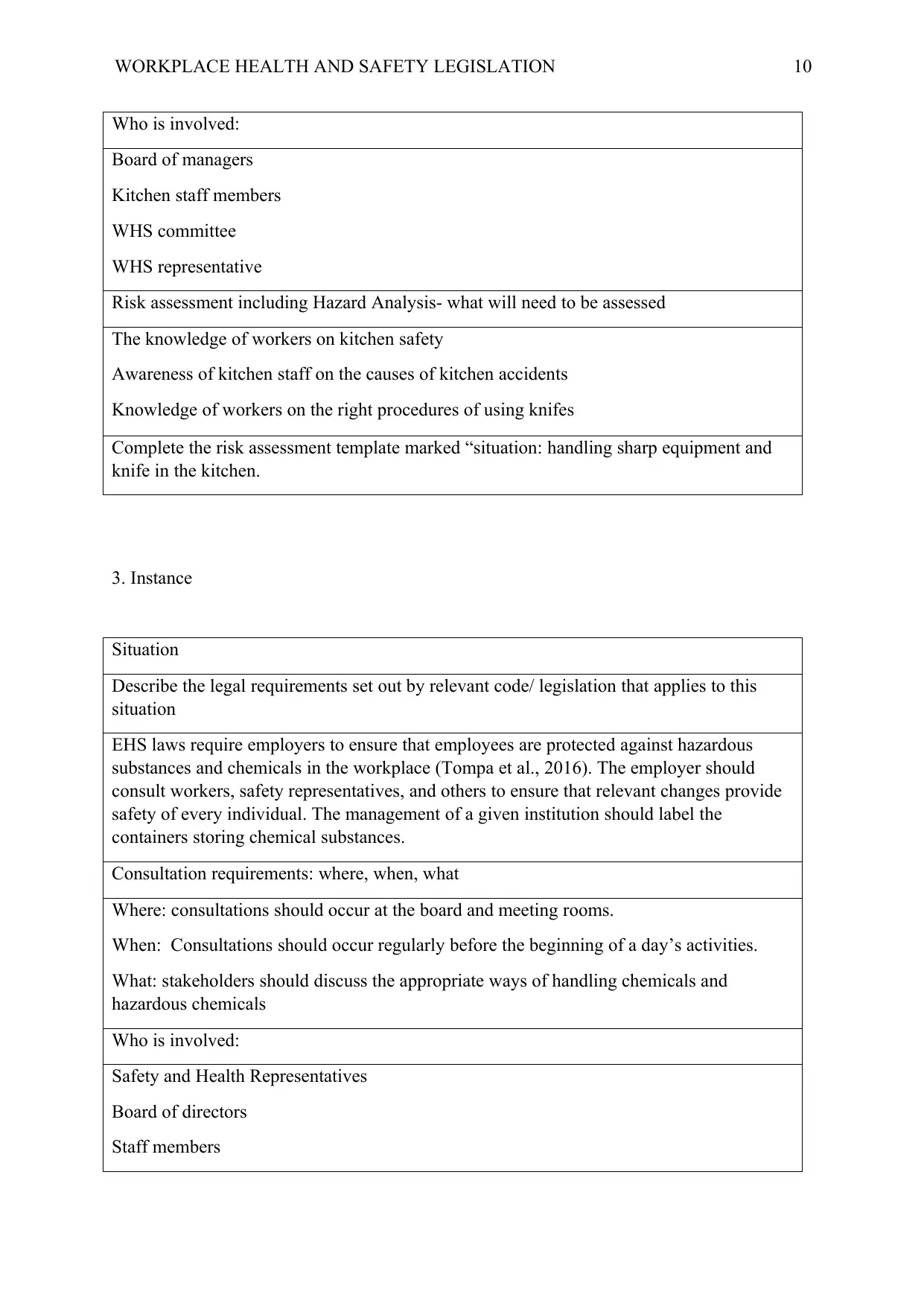
WORKPLACE HEALTH AND SAFETY LEGISLATION 10
Who is involved:
Board of managers
Kitchen staff members
WHS committee
WHS representative
Risk assessment including Hazard Analysis- what will need to be assessed
The knowledge of workers on kitchen safety
Awareness of kitchen staff on the causes of kitchen accidents
Knowledge of workers on the right procedures of using knifes
Complete the risk assessment template marked “situation: handling sharp equipment and
knife in the kitchen.
3. Instance
Situation
Describe the legal requirements set out by relevant code/ legislation that applies to this
situation
EHS laws require employers to ensure that employees are protected against hazardous
substances and chemicals in the workplace (Tompa et al., 2016). The employer should
consult workers, safety representatives, and others to ensure that relevant changes provide
safety of every individual. The management of a given institution should label the
containers storing chemical substances.
Consultation requirements: where, when, what
Where: consultations should occur at the board and meeting rooms.
When: Consultations should occur regularly before the beginning of a day’s activities.
What: stakeholders should discuss the appropriate ways of handling chemicals and
hazardous chemicals
Who is involved:
Safety and Health Representatives
Board of directors
Staff members
Who is involved:
Board of managers
Kitchen staff members
WHS committee
WHS representative
Risk assessment including Hazard Analysis- what will need to be assessed
The knowledge of workers on kitchen safety
Awareness of kitchen staff on the causes of kitchen accidents
Knowledge of workers on the right procedures of using knifes
Complete the risk assessment template marked “situation: handling sharp equipment and
knife in the kitchen.
3. Instance
Situation
Describe the legal requirements set out by relevant code/ legislation that applies to this
situation
EHS laws require employers to ensure that employees are protected against hazardous
substances and chemicals in the workplace (Tompa et al., 2016). The employer should
consult workers, safety representatives, and others to ensure that relevant changes provide
safety of every individual. The management of a given institution should label the
containers storing chemical substances.
Consultation requirements: where, when, what
Where: consultations should occur at the board and meeting rooms.
When: Consultations should occur regularly before the beginning of a day’s activities.
What: stakeholders should discuss the appropriate ways of handling chemicals and
hazardous chemicals
Who is involved:
Safety and Health Representatives
Board of directors
Staff members
Paraphrase This Document
Need a fresh take? Get an instant paraphrase of this document with our AI Paraphraser
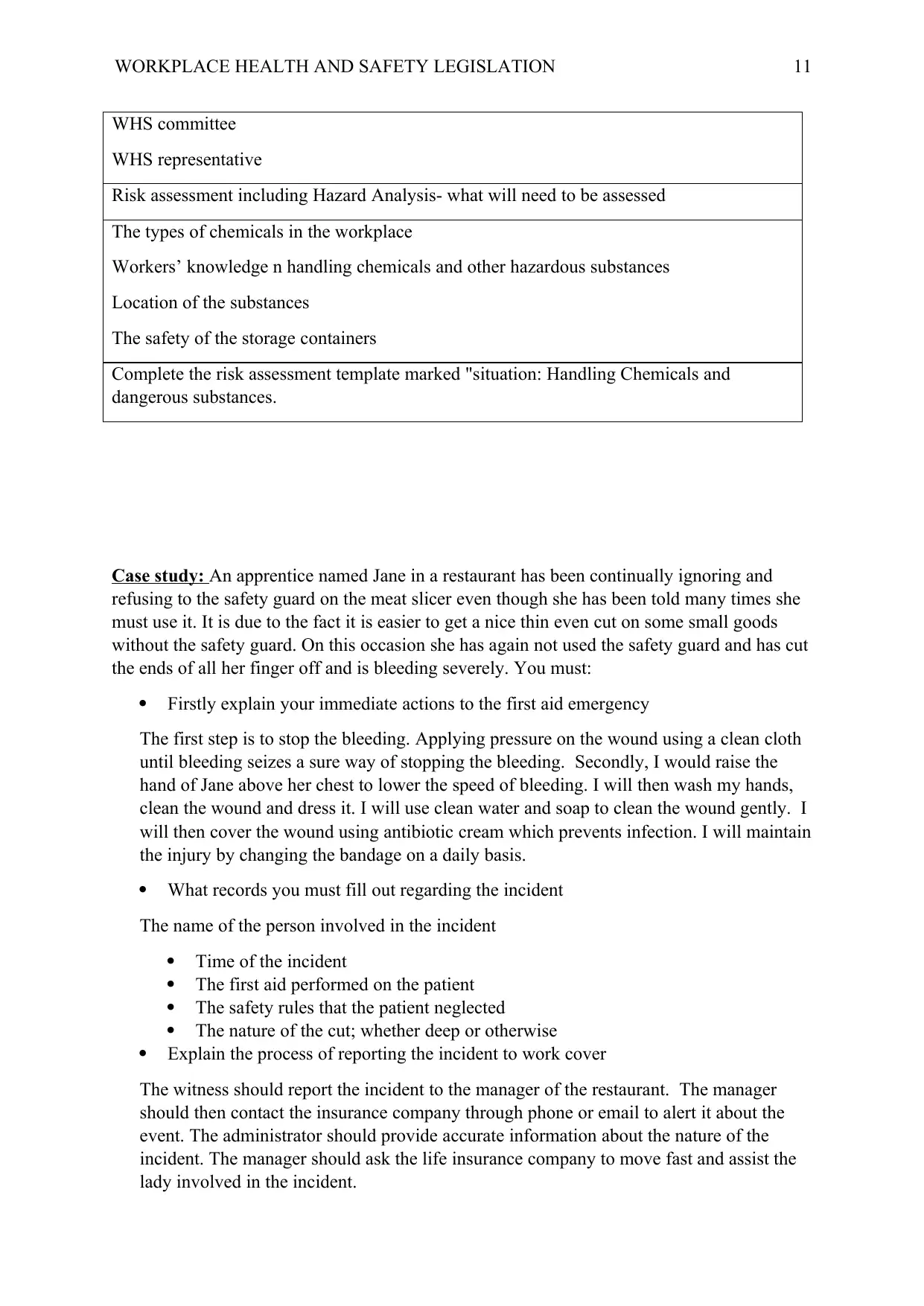
WORKPLACE HEALTH AND SAFETY LEGISLATION 11
WHS committee
WHS representative
Risk assessment including Hazard Analysis- what will need to be assessed
The types of chemicals in the workplace
Workers’ knowledge n handling chemicals and other hazardous substances
Location of the substances
The safety of the storage containers
Complete the risk assessment template marked "situation: Handling Chemicals and
dangerous substances.
Case study: An apprentice named Jane in a restaurant has been continually ignoring and
refusing to the safety guard on the meat slicer even though she has been told many times she
must use it. It is due to the fact it is easier to get a nice thin even cut on some small goods
without the safety guard. On this occasion she has again not used the safety guard and has cut
the ends of all her finger off and is bleeding severely. You must:
Firstly explain your immediate actions to the first aid emergency
The first step is to stop the bleeding. Applying pressure on the wound using a clean cloth
until bleeding seizes a sure way of stopping the bleeding. Secondly, I would raise the
hand of Jane above her chest to lower the speed of bleeding. I will then wash my hands,
clean the wound and dress it. I will use clean water and soap to clean the wound gently. I
will then cover the wound using antibiotic cream which prevents infection. I will maintain
the injury by changing the bandage on a daily basis.
What records you must fill out regarding the incident
The name of the person involved in the incident
Time of the incident
The first aid performed on the patient
The safety rules that the patient neglected
The nature of the cut; whether deep or otherwise
Explain the process of reporting the incident to work cover
The witness should report the incident to the manager of the restaurant. The manager
should then contact the insurance company through phone or email to alert it about the
event. The administrator should provide accurate information about the nature of the
incident. The manager should ask the life insurance company to move fast and assist the
lady involved in the incident.
WHS committee
WHS representative
Risk assessment including Hazard Analysis- what will need to be assessed
The types of chemicals in the workplace
Workers’ knowledge n handling chemicals and other hazardous substances
Location of the substances
The safety of the storage containers
Complete the risk assessment template marked "situation: Handling Chemicals and
dangerous substances.
Case study: An apprentice named Jane in a restaurant has been continually ignoring and
refusing to the safety guard on the meat slicer even though she has been told many times she
must use it. It is due to the fact it is easier to get a nice thin even cut on some small goods
without the safety guard. On this occasion she has again not used the safety guard and has cut
the ends of all her finger off and is bleeding severely. You must:
Firstly explain your immediate actions to the first aid emergency
The first step is to stop the bleeding. Applying pressure on the wound using a clean cloth
until bleeding seizes a sure way of stopping the bleeding. Secondly, I would raise the
hand of Jane above her chest to lower the speed of bleeding. I will then wash my hands,
clean the wound and dress it. I will use clean water and soap to clean the wound gently. I
will then cover the wound using antibiotic cream which prevents infection. I will maintain
the injury by changing the bandage on a daily basis.
What records you must fill out regarding the incident
The name of the person involved in the incident
Time of the incident
The first aid performed on the patient
The safety rules that the patient neglected
The nature of the cut; whether deep or otherwise
Explain the process of reporting the incident to work cover
The witness should report the incident to the manager of the restaurant. The manager
should then contact the insurance company through phone or email to alert it about the
event. The administrator should provide accurate information about the nature of the
incident. The manager should ask the life insurance company to move fast and assist the
lady involved in the incident.
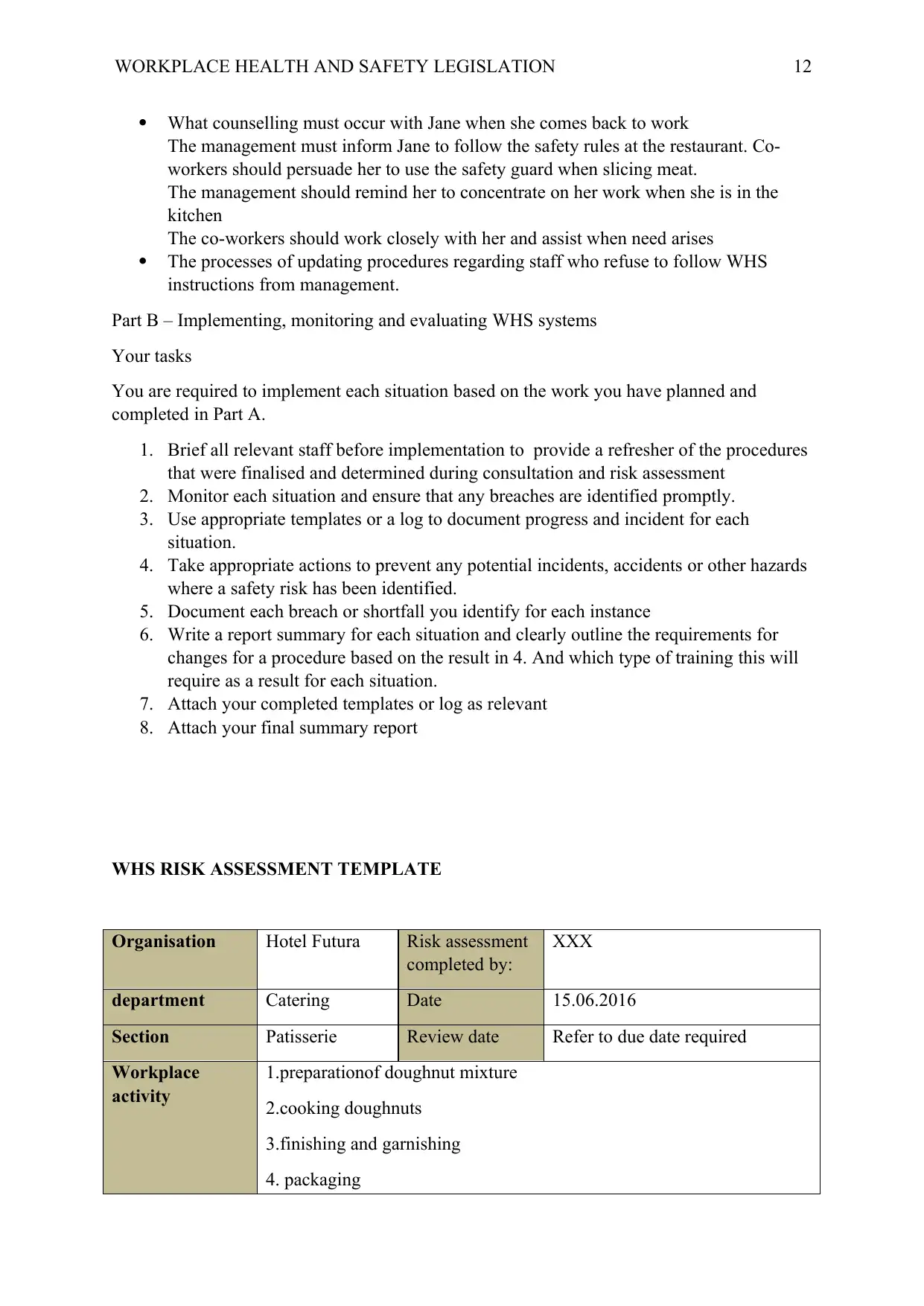
WORKPLACE HEALTH AND SAFETY LEGISLATION 12
What counselling must occur with Jane when she comes back to work
The management must inform Jane to follow the safety rules at the restaurant. Co-
workers should persuade her to use the safety guard when slicing meat.
The management should remind her to concentrate on her work when she is in the
kitchen
The co-workers should work closely with her and assist when need arises
The processes of updating procedures regarding staff who refuse to follow WHS
instructions from management.
Part B – Implementing, monitoring and evaluating WHS systems
Your tasks
You are required to implement each situation based on the work you have planned and
completed in Part A.
1. Brief all relevant staff before implementation to provide a refresher of the procedures
that were finalised and determined during consultation and risk assessment
2. Monitor each situation and ensure that any breaches are identified promptly.
3. Use appropriate templates or a log to document progress and incident for each
situation.
4. Take appropriate actions to prevent any potential incidents, accidents or other hazards
where a safety risk has been identified.
5. Document each breach or shortfall you identify for each instance
6. Write a report summary for each situation and clearly outline the requirements for
changes for a procedure based on the result in 4. And which type of training this will
require as a result for each situation.
7. Attach your completed templates or log as relevant
8. Attach your final summary report
WHS RISK ASSESSMENT TEMPLATE
Organisation Hotel Futura Risk assessment
completed by:
XXX
department Catering Date 15.06.2016
Section Patisserie Review date Refer to due date required
Workplace
activity
1.preparationof doughnut mixture
2.cooking doughnuts
3.finishing and garnishing
4. packaging
What counselling must occur with Jane when she comes back to work
The management must inform Jane to follow the safety rules at the restaurant. Co-
workers should persuade her to use the safety guard when slicing meat.
The management should remind her to concentrate on her work when she is in the
kitchen
The co-workers should work closely with her and assist when need arises
The processes of updating procedures regarding staff who refuse to follow WHS
instructions from management.
Part B – Implementing, monitoring and evaluating WHS systems
Your tasks
You are required to implement each situation based on the work you have planned and
completed in Part A.
1. Brief all relevant staff before implementation to provide a refresher of the procedures
that were finalised and determined during consultation and risk assessment
2. Monitor each situation and ensure that any breaches are identified promptly.
3. Use appropriate templates or a log to document progress and incident for each
situation.
4. Take appropriate actions to prevent any potential incidents, accidents or other hazards
where a safety risk has been identified.
5. Document each breach or shortfall you identify for each instance
6. Write a report summary for each situation and clearly outline the requirements for
changes for a procedure based on the result in 4. And which type of training this will
require as a result for each situation.
7. Attach your completed templates or log as relevant
8. Attach your final summary report
WHS RISK ASSESSMENT TEMPLATE
Organisation Hotel Futura Risk assessment
completed by:
XXX
department Catering Date 15.06.2016
Section Patisserie Review date Refer to due date required
Workplace
activity
1.preparationof doughnut mixture
2.cooking doughnuts
3.finishing and garnishing
4. packaging
⊘ This is a preview!⊘
Do you want full access?
Subscribe today to unlock all pages.

Trusted by 1+ million students worldwide
1 out of 18
Related Documents
Your All-in-One AI-Powered Toolkit for Academic Success.
+13062052269
info@desklib.com
Available 24*7 on WhatsApp / Email
![[object Object]](/_next/static/media/star-bottom.7253800d.svg)
Unlock your academic potential
Copyright © 2020–2025 A2Z Services. All Rights Reserved. Developed and managed by ZUCOL.




